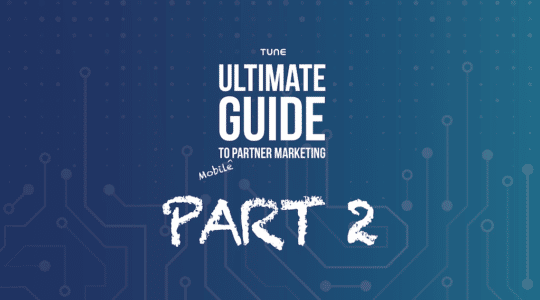
This article on mobile ad networks was first posted on iMediaConnection.
Mobile advertising spend is expected to grow from $3.3 billion to $20.6 billion by 2015 (according to Gartner). A major component in this projection is the staggering number of users moving to smartphones who are quickly growing more comfortable with mobile apps as well as their mobile browsing experience.
With those users spending even more time on their mobile devices, advertisers are itching to get their attention, and the best way to do it is through mobile ad networks. Just like the advertising giants on the web like Yahoo Network, Real Media, AdBrite, and Google Ad Network, mobile has spawned a new host of major players that include InMobi, Jumptap, Millennial Media, Tapjoy, and others. Of course, we’ve also watched the big guns enter the race, including Google, which purchased AdMob, and Microsoft, which created Microsoft Mobile Advertising.

The two main reasons mobile advertising is exploding are:
Mobile ads are highly targetable — enormous amounts of information are available about smartphone users, helping you to determine exactly which demographics you need to target.
You can reach customers at the point of purchase — reaching out to customers as they are actively making purchase decisions gives marketers an incredible opportunity to convert them.
However, it is important to remember that advertising in this mobile space is relatively new, and no one really knows where it is heading. For example, is it more efficient to drive users to install your mobile app or to send them directly to your shopping cart on the mobile version of your website? If someone clicks my ad because it was required for them to get a badge or move up a level in a game, is that user still valuable to me? Marketers around the world are still working to solve questions like these, and it’s important to keep in mind that we are still in a very early stage of mobile advertising. I won’t be surprised at all to see completely new advertising methods take shape over the coming year, completely tailored to the mobile user experience.
Finding the Right Mobile Ad Networks
The most important factor in deciding to work with any ad network, mobile or otherwise, is what type of traffic you are looking for. Are you just building your brand and wanting more eyeballs, looking for more clicks to your site, or maybe you need more users to install your mobile app or purchase a product. Each ad network has unique strengths and weaknesses at this point, but you can narrow most of them into a few categories.
Blind networks
These networks usually have access to a large quantity of smaller publisher sites and applications. They don’t really give you insight into all the publishers you’re working with. Depending on how qualified your new users need to be, blind networks can be an excellent answer to getting some volume pumping (e.g., AdMob, InMobi, Adfonic, BuzzCity).
Premium blind networks
These networks focus on medium-sized level publishers and above, but still don’t show you who you’re working with. If it doesn’t matter which sites are sending you traffic as along as they are premium sites, these networks work really well. These networks often have pay per click (CPC) and per install (CPI) options (e.g., Millennial Media, Jumptap).
Premium networks
Mobile ad networks that just work with a few, really high quality publishers. These are often huge destination sites or even mobile operators, and you will often need to pay like you would a display network (CPM) (e.g., Microsoft, AOL, Nokia).
Incentivized networks
Incentivized ad networks encourage users to install a mobile app or complete an advertiser-defined action in exchange for some sort of virtual currency. The traffic may be blind or transparent from these networks. This type of advertising is performance based, usually cost per install or cost per action (CPA) (e.g., OfferMobi, SponsorPay, Tapjoy).
Right now, there really is no clear winner among mobile advertising networks. In fact, new networks are developing every month, showing incredible numbers, and there is no definitive way to know the quality of a network without trying it for your specific business model. We’re still waiting for a study that can reveal more, but in the meantime it is important to go with the style of network you feel comfortable with and test the quality of the traffic yourself.
If you’re still a little unsure of your specific requirements even after you’ve determined your broad business objective on mobile, you can spread advertising dollars around to multiple major ad networks and monitor results. You have to do the same thing with new web-based advertising methods such as Facebook and Twitter, but I can almost guarantee that with mobile ad networks, you’ll get more bang for your buck across the board.
Mobile Web or Mobile App
A lot of our clients only think about mobile advertising for mobile apps, but mobile websites (websites tailored for mobile devices) can be advertised on mobile ad networks as well. Most mobile ad networks allow you to advertise either mobile apps or mobile websites and enable you to set up advertising campaigns accordingly.
Tracking advertising campaigns for mobile websites on mobile ad networks can be done relatively simply since most traditional tracking methods work on smartphones such as client-based cookies and server-to-server tracking.
However, tracking advertising campaigns for mobile apps on mobile ad networks can get complicated quickly since traditional tracking methods don’t work. When it comes to mobile apps, users leave their web browsers, entering into app stores and marketplaces, and once they’ve installed a mobile app on their device and open it, they continue to operate without a web browser. These are the tracking problems we’ve been solving for some of our largest clients. In the coming months you’ll begin to see the growing need to quantify the value of advertising for mobile apps.
Monitoring Your Mobile Advertising
Just like web advertising, you have to monitor the value of the traffic coming in as well as the effectiveness of your ads. Just because users are not installing your app does not mean it is the ad network’s fault and vice versa. If you don’t track your success and failures, you really have no way to optimize your campaigns and get the most out of every dollar.
Most of the better mobile ad networks offer some tools for tracking performance, though these are still in extremely early stages. Some networks integrate with other analytics tools like DART and Omniture (if you’re at the enterprise level), and even Google Analytics can provide some insight for Android apps and mobile web. Just like picking the right ad network, finding the right analytics or tracking solution really goes back to your business goals.
Moving Mobile Forward
Advertising on mobile isn’t significantly different from other forms of online advertising, so there is no reason for hesitation. In fact, if you’re already familiar with major web advertising channels and ad networks, you’ll be a pro on mobile in no time. This is your chance to become a part of the fastest growing and most forward thinking advertising segment, and I strongly encourage you to jump in with both feet. The more you learn, the better your ads will be and the tighter the relationships you’ll build with ad networks as they continue to grow.
Treat mobile advertising as an exciting new opportunity with no limits. Watch as new mobile ad networks, advertising strategies, and analytics solutions spring up all around you in the next few years and get in on the ground level of something that is certainly going to be a very big deal.
Track your mobile advertising campaigns and affiliate programs with the TUNE Partner Marketing Platform.
Author
A digital marketer by background, Peter is the former CEO of TUNE, the enterprise platform for partner marketing. In 2018, he sold TUNE’s mobile measurement product to Branch, unifying measurement and user experience. He led TUNE’s efforts to bring better management technology and automation to marketing partnerships, across affiliates, influencers, networks, and business development relationships. Follow @peterhamilton




Leave a Reply
You must be logged in to post a comment.